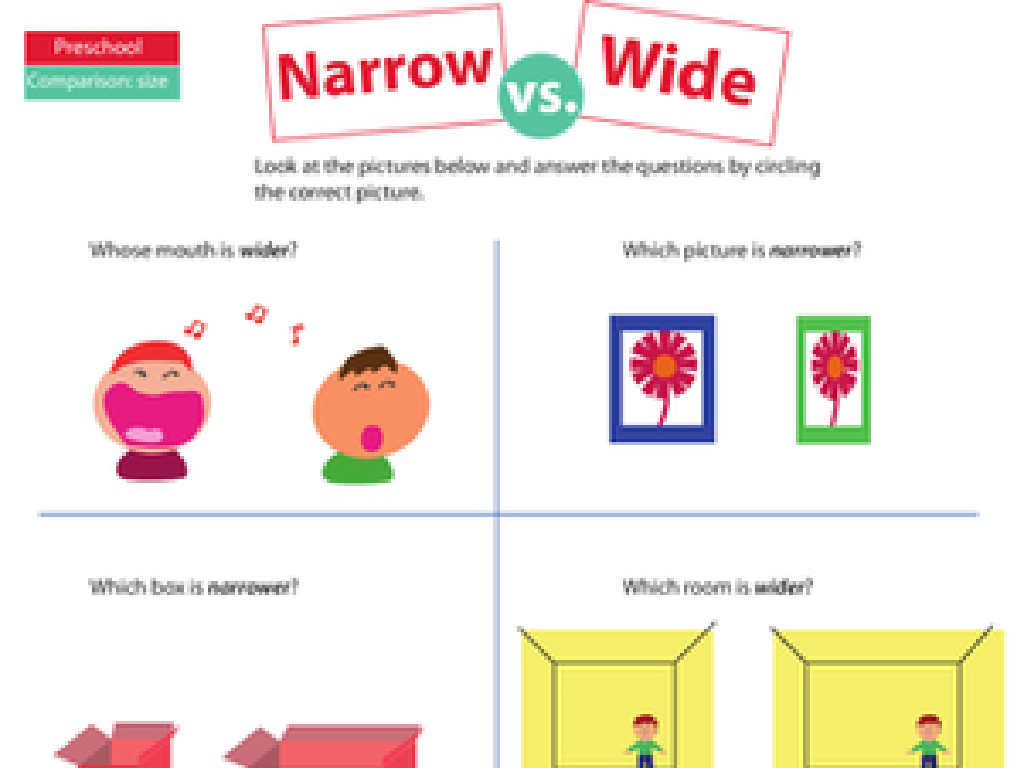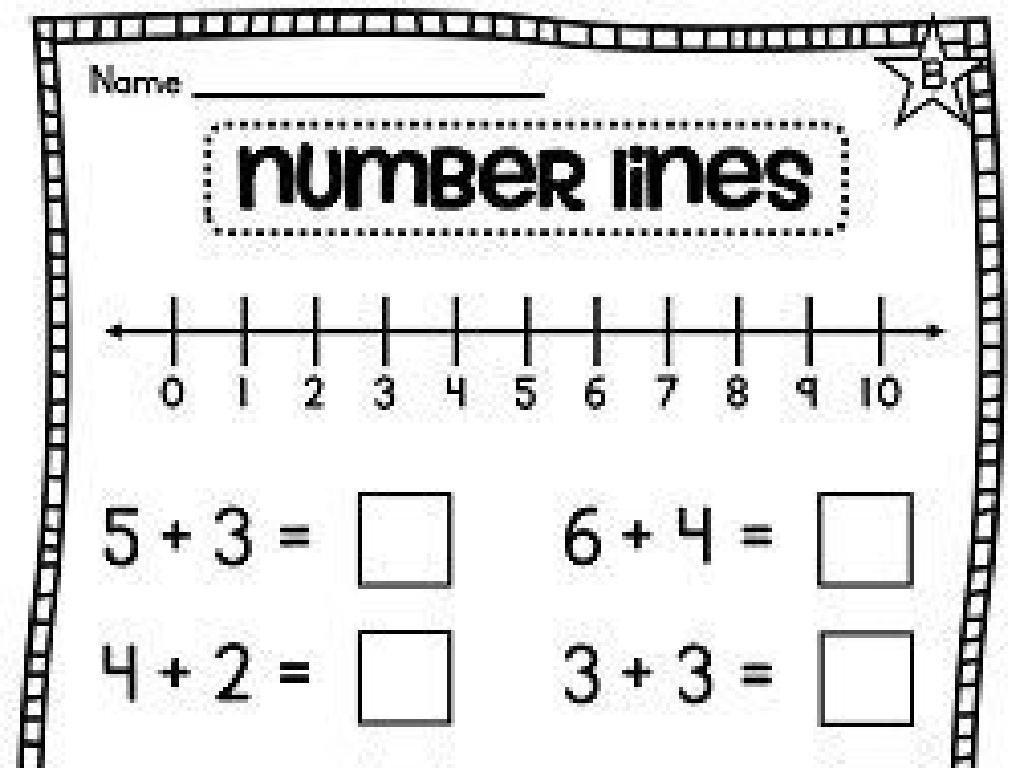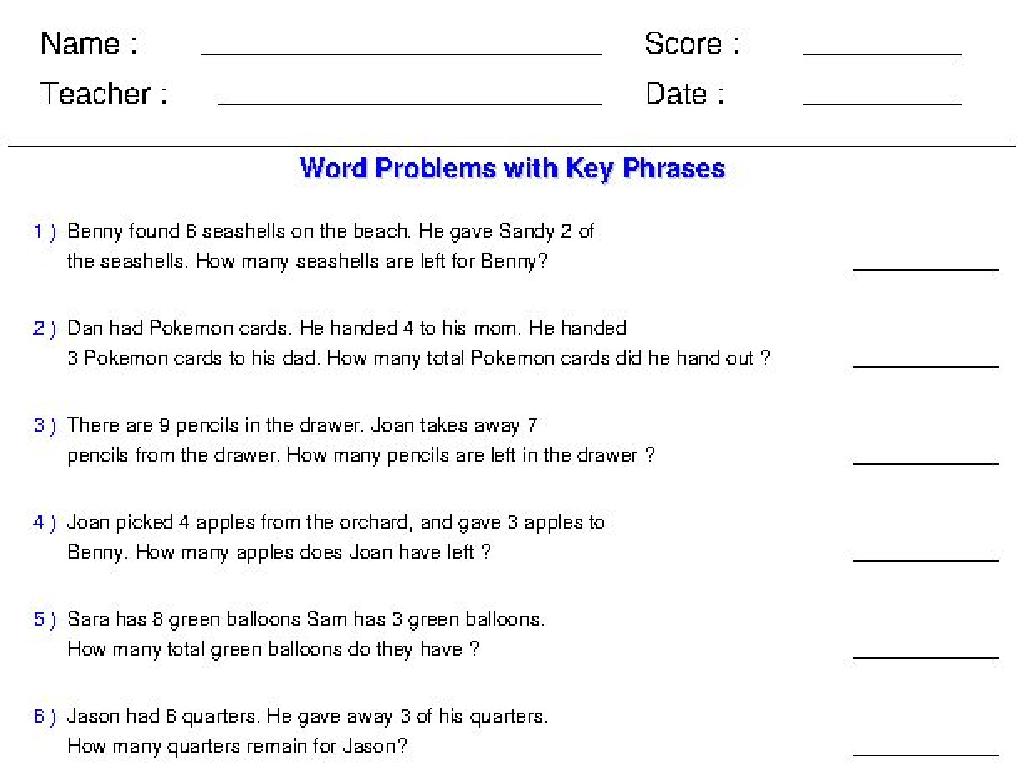Prime Factorization
Subject: Math
Grade: Fifth grade
Topic: Factors, Multiples, And Divisibility
Please LOG IN to download the presentation. Access is available to registered users only.
View More Content
Welcome to Prime Factorization!
– Understanding factors and multiples
– Factors are numbers we can multiply to get another number, while multiples are what we get after multiplying.
– Exploring prime numbers
– Primes are numbers greater than 1 that have only two factors: 1 and themselves.
– Defining prime factorization
– Prime factorization is breaking down a number into its prime number factors.
– Applying prime factorization
– Let’s find the prime factors of 30 by dividing it by the smallest prime numbers.
|
This slide introduces the concept of prime factorization, a fundamental topic in understanding number theory for fifth graders. Begin by explaining factors and multiples to ensure a solid foundation. Then, move on to prime numbers, highlighting their unique property of having only two factors. Introduce prime factorization as a method of expressing numbers as a product of prime factors. Use interactive examples, such as finding the prime factors of 30 (2 x 3 x 5), to demonstrate the process. Encourage students to practice with different numbers and provide guidance on starting with the smallest primes. This activity will help solidify their understanding of the concept.
Understanding Factors
– Define a factor
– A factor is a number that divides another number without leaving a remainder.
– Examples of factors
– For example, factors of 6 are 1, 2, 3, and 6.
– Factors for numbers 1-10
– 1:1, 2:1,2, 3:1,3, 4:1,2,4, 5:1,5, 6:1,2,3,6, 7:1,7, 8:1,2,4,8, 9:1,3,9, 10:1,2,5,10
– Practice finding factors
|
Begin the lesson by explaining what a factor is, emphasizing that it’s a whole number that can divide another whole number evenly, with zero remainder. Provide clear examples to illustrate the concept, such as showing that 2 and 3 are factors of 6 because 6 divided by 2 equals 3, and 6 divided by 3 equals 2, both without any remainder. Then, go through the factors of numbers 1-10, which are foundational for understanding divisibility and prime factorization. Encourage students to practice finding factors of different numbers to reinforce the concept. This will prepare them for learning about prime factorization, where they will break down numbers into their most basic factors: prime numbers.
Understanding Prime Numbers
– Define Prime Numbers
– A prime number has only two factors: 1 and itself.
– Characteristics of Primes
– Primes are greater than 1 and cannot be evenly divided by other numbers.
– Identifying Primes in a List
– Use tests of divisibility to pick out primes from a list of numbers.
|
This slide introduces the concept of prime numbers, which are the building blocks of all natural numbers. Emphasize that a prime number is a whole number greater than 1 that cannot be made by multiplying other whole numbers. Discuss characteristics such as the fact that primes only have two distinct factors: 1 and themselves. To identify prime numbers from a list, students can use divisibility rules to test if numbers can be divided evenly by numbers other than 1 and themselves. For example, in the list 2, 3, 4, 5, 7, 8, 9, 10, the prime numbers are 2, 3, 5, and 7. Provide additional examples and encourage students to practice with different lists to become comfortable with identifying prime numbers.
Exploring Prime Factorization
– What is prime factorization?
– Breaking down a number into its prime number factors.
– Importance of prime factorization
– Helps simplify fractions & find common denominators.
– How to find prime factors
– Use factor trees or division method to find factors.
– Practice with examples
– Let’s factorize 30 and 45 together as a class.
|
Prime factorization is the process of decomposing a composite number into its prime factors. This concept is crucial for understanding other areas of mathematics, such as greatest common divisors and least common multiples, which are essential for working with fractions. Teach the students the step-by-step methods of finding prime factors, such as creating a factor tree or using systematic division. Provide ample practice with examples and encourage students to explain their thought process. This will help solidify their understanding and prepare them for more complex operations involving fractions.
Factor Trees: Breaking Down Numbers
– What is a factor tree?
– A diagram to find prime factors of a number
– Prime factorization of 36
– 36 breaks down into 2×18, then 2x2x9, and finally 2x2x3x3
– Step-by-step factor tree creation
– Start with a number, break it into two factors, and continue until all are prime
– Class activity: Build your own tree
|
Introduce the concept of a factor tree as a visual tool to find all the prime factors of a number. Use 36 as an example to demonstrate the process: start by dividing the number into two factors, 2 and 18, then break down 18 into 2 and 9, and finally, factor 9 into 3 and 3, resulting in the prime factorization of 36 as 2x2x3x3. For the class activity, have students create their own factor trees with different numbers. Provide guidance on how to start with a composite number and break it down step by step until only prime numbers are left. Offer several examples for students to work on, such as 24, 48, and 60, and encourage them to compare their results with classmates.
Prime Factorization: The Division Method
– Understanding the Division Method
– A way to find prime factors by dividing the number by its smallest prime factor until the result is 1
– Step-by-Step Division Guide
– Start with the smallest prime number that divides into 60, which is 2
– Example: Factorize 60
– 60 ÷ 2 = 30, 30 ÷ 2 = 15, 15 ÷ 3 = 5, and 5 is a prime number
– Practice with different numbers
|
The Division Method is a systematic approach to prime factorization where students divide the number by the smallest prime factor until they reach 1. Begin by explaining the method, then demonstrate with an example, such as the prime factorization of 60. Show that dividing 60 by 2 (the smallest prime factor) gives 30, then divide 30 by 2 again to get 15, and continue until the result is a prime number. Encourage students to practice this method with different numbers as homework to reinforce the concept.
Prime Factorization Practice
– Practice with more examples
– Pair up for problem-solving
– Work together to find prime factors
– Share answers with the class
– Discuss different methods used
– Learn from each other
|
This slide is designed to engage students in active learning through practice problems on prime factorization. Students should first attempt additional examples individually to reinforce their understanding. Then, they will pair up with a classmate to work on problems collaboratively, which encourages peer learning and problem-solving skills. Afterward, pairs will share their answers and methods with the class, providing an opportunity for discussion and learning from different approaches. The teacher should facilitate by walking around to assist pairs as needed and leading the class discussion to highlight effective strategies and common misconceptions. Possible activities include creating factor trees, using division ladders, or finding prime factors for numbers in a certain range.
Class Activity: Prime Factorization Game
– Understand game rules
– Split into teams
– Solve factorization puzzles
– Break down numbers into prime factors
– Compete for the most correct answers
– Tally points for each correct puzzle
|
This interactive game is designed to help students practice prime factorization in a fun and competitive way. Begin by explaining the rules of the game, ensuring that all students understand the objective and how to play. Divide the class into small teams, providing each with a set of prime factorization puzzles. These puzzles will consist of various composite numbers that students must break down into their prime factors. As teams solve the puzzles, they should write down their answers. Once all puzzles are completed, review the answers as a class and tally the points for each team. The team with the most correct answers will be declared the winner. To keep the game engaging, consider offering a small prize or recognition for the winning team. This activity not only reinforces the concept of prime factorization but also encourages teamwork and critical thinking.
Recap: Prime Factorization
– Review of prime factorization
– Breaking down numbers into prime number factors
– Significance of prime numbers
– Prime numbers are the building blocks of all numbers
– Prime factorization in daily life
– Used in computing LCM and GCD, essential in problem-solving
– Encouraging further practice
|
As we conclude, let’s recap the process of prime factorization, which involves breaking down composite numbers into their prime number factors. Understanding prime numbers is crucial as they are the ‘building blocks’ of all numbers. Highlight the practical applications of prime factorization in real life, such as finding the least common multiple (LCM) and greatest common divisor (GCD) of numbers, which are vital skills in various problem-solving scenarios. Encourage students to continue practicing prime factorization with different numbers to gain fluency and confidence in this concept.
Homework: Mastering Prime Factorization
– Practice with assigned problems
– Study for the prime factorization quiz
Review your notes on prime numbers and how to create factor trees.
– Compile questions for next class
Write down any difficulties you’re having to discuss in class.
– Review prime numbers and factor trees
Remember, prime numbers only have two factors: 1 and themselves!
|
This homework assignment is designed to reinforce the concept of prime factorization learned in class. Students are expected to complete the problems provided to practice breaking down composite numbers into their prime factors. They should also prepare for an upcoming quiz that will test their understanding of prime numbers and their ability to perform prime factorization. Encourage students to review their notes, especially the method of creating factor trees, and to identify prime numbers. Remind them to bring any questions or areas of confusion to the next class so that they can be addressed. This will help ensure that all students are on the same page and feel confident in their understanding of the material.






